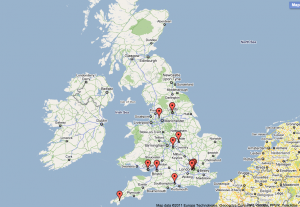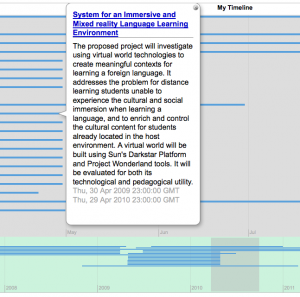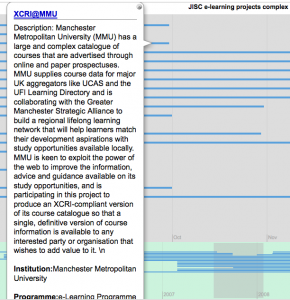After a good session with the folks from the Achievement Standards Network (ASN), and earlier discussions with Link Affiliates, I could see the potential of linking LEAP2a portfolios with ASN curriculum information and learning resources. So I implemented a proof of concept.
Fortunately, almost all the information required is already available as RDF: the ASN makes its machine readable curricula available in that format, and Zotero (my bibliography tool of choice) happily puts out its data in RDF too. What still needed to be done was the ability to turn LEAP2a eportfolios into RDF.
That took some doing, but since LEAP2a is built around the IETF Atom newsfeed format, there were at least some existing XSL transformations to build on. I settled on the one included in the open source OpenLink Virtuoso data management server, since that’s what I used for the subsequent Linked Data meshing too. Also, the OpenLink Virtuoso Atom-to-RDF XSLT came out of their ‘sponger’ middleware layer, which allows you to treat all kinds of structured data as if they were RDF datasources. That means that it ought to be possible to built a wee LEAP2a sponger cartridge around my leap2rdf.xslt, which then allows OpenLink Virtuoso to treat any LEAP2a portfolio as RDF.
The result still has limitations: the leap2rdf.xslt only works on LEAP2a records with the new, proper namespace, and it only works well on those records that use URIs, but not those that use Compact URIs (CURIEs). Fixing these things is perfectly possible, but would take two or three more days that I didn’t have.
So, having spotted my ponds of RDF triples and filled one up, it’s time to go fishing. But for what and why?
Nigel Ward and Nick Nicholas of Link Affiliates have done an excellent job in explaining the why of machine readable curriculum data, so I’ve taken the immediate advantages that they identified, and illustrated them with noddy proof-of-concept hows:
1. Learning resources can be easily and unambiguously tagged with relevant learning outcomes.
For this one, I made a query that looks up a work (Robinson Crusoe) in my Zotero bibliographic database and gets a download link for it, then checks whether the work supports any known learning outcomes (in my own 6-lines-of-RDF repository), and then gets a description of that learning outcome from the ASN. You can see the results in CSV.
It ought to have been possible to use a bookmarking service for the learning resource to learning outcome mapping, but hand writing the equivalent of
‘this book’ ‘aligns to’ ‘that learning outcome’
seemed easier 
2. A student’s progress can be easily and unambiguously mapped to the curriculum.
To illustrate this one, I’ve taken Theophilus Thistledown’s LEAP2a example portfolio, and added some semi-appropriate Californian K-12 learning outcomes from the ASN against the activities Theophilus recorded in his portfolio. (Anyone can add such ASN statements very easily and legally within the scope of the LEAP2a specification, by the way) I then RDFised the lot with my leap2rdf XSLT.
I queried the resulting RDF portfolio to see what learning outcomes were supported by one particular learning activity, and I then got descriptions of each of these learning outcomes from the ASN, and also got a list of other learning outcomes that belong to the same curriculum standard. That is, related learning outcomes that Theophilus could still work on. This is what the SPARQL looks like, and the results can be seen here. Beware that a table is not the most helpful way of presenting this information- a line and a list would be better.
3. Lesson plans and learning paths to be easily and unambiguously mapped to the curriculum.
This is what I think of as the classic case: I’ve taken an RDFised, ASN enhanced LEAP2a eportfolio, and looked for the portfolio owner’s name, any relevant activities that had a learning outcome mapped against them, then fished out the identifier of that learning outcome and a description of same from the ASN. Here’s the SPARQL, and there’s the result in CSV.
Together, these give a fairly good of what Robinson Crusoe was up to, according to the Californian K-12 curriculum, and gives a springboard for further exploration of things like comparison of the learning outcomes he aimed for then with later statements of the same outcome or the links between the Californian outcomes with those of other jurisdictions.
4. The curriculum can drive content discovery: teachers and learners want to find online resources matching particular curriculum outcomes they are teaching.
While sitting behind his laptop, Robinson might be wondering whether he can get hold of some good learning resources for the learning activities he’s busy with. This query will look at his portfolio for activities with ASN learning outcomes and check those outcomes against the outcome-to-resource mapping repository I mentioned earlier. It will then look up some more information about the resources from the Zotero bibliographic database, including a download link- like so
The nice thing is that this approach should scale up nicely all the way from my six lines of RDF to a proper repository.
5. Other e-learning applications can be configured to use the curriculum structure to share information.
A nice and simple example could be a tool that lets you discover other learners with the same learning outcome as a goal in their portfolio. This sample query looks through both Theophilus and Robinson’s eportfolios, identifies any ASN learning outcomes they have in common, and then gets some descriptions of that outcome from the ASN, with this result.
Lessons learned
Of all the steps in this and other meshups, deriving decent RDF from XML is easily the hardest and most time consuming. Deriving RDF from spreadsheets or databases seems much easier, and once you have all your source data in RDF, the rest is easy.
Even using the distributed graph pattern I described in a previous post, querying across several datasets can still be a bit slow and cumbersome. As you may have noticed if you follow the sample query links, uriburner.com (the hosted version of OpenLink Virtuoso) will take it’s time in responding to a query if it hasn’t got a copy of all relevant datasets downloaded, parsed and stored. Using a SPARQL endpoint on your own machine clearly makes a lot of sense.
Perhaps more importantly, all the advantages of machine readable curricula that Nigel and Nick outlined are pretty easily achievable. The queries and the basic tables they produce took me one evening. The more long term advantages Nigel and Nick point out – persistence of curricula, mapping different curricula to each other, and dealing with differences in learning outcome scope – are all equally do-able using the linked data stack.
Most importantly, though, are the meshups that no-one has dreamed of yet.
What’s next
For other people to start coming up with those meshups, though, some further development needs to happen. For one, the leap2rdf.xslt needs to deal with a greater variety of LEAP2a eportfolios. A bookmark service that lets you assert simple triples with tags, and expose those triples as RDF with URIs (rather than just strings) would be great. The query results could look a bit nicer too.
The bigger deal is the data: we need more eportfolios to be available in either LEAP2a or LEAP2r formats as a matter of course, and more curricula need be described using the ASN.
Beyond that, the trickier question is who will do the SPARQL querying and how. My sense is that the likeliest solution is for people to interact with the results of pre-fabbed SPARQL queries, which they can manipulate a bit using one or two parameters via some nice menus. Perhaps all that the learners, teachers, employers and others will really notice is more relevant, comprehensive and precisely tailored information in convenient websites or eportfolio systems.
Resources
The leap2rdf.xslt is also available here. Please be patient with its many flaws- improvements are very welcome.



